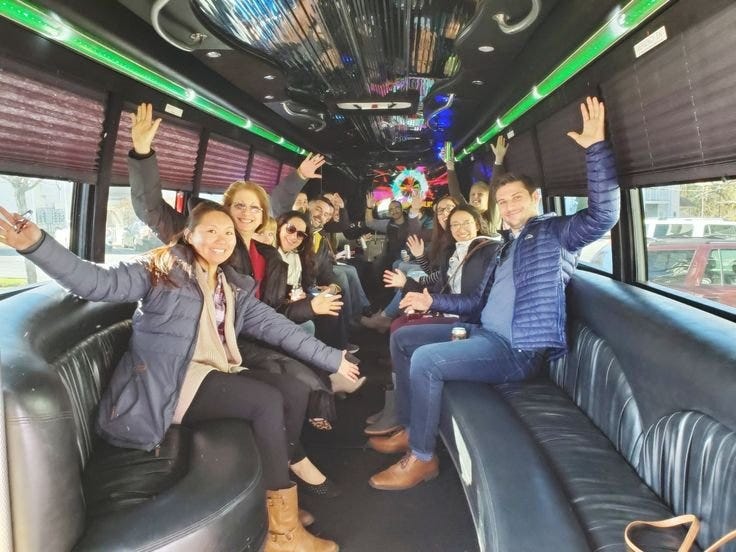20 Great Ideas For Deciding On Employee Shuttle Websites
Top 10 Tips To Assist You In Planning And Covering Your Employee Shuttle Transportation RoutesHere are 10 top tips for planning routes and covering employee shuttles.
1. Understand employee needs
Focus groups and surveys are a great way to determine where employees reside and their preferences for shuttle times. Also, any special needs (like accessibility needs) are determined. It is crucial to collect this data to develop routes that increase satisfaction of customers.
2. Analyse traffic patterns
Research patterns of traffic and peak hours in the area surrounding your organization. Google Maps can be used to identify busy routes. Beware of them during shuttle time. This will minimize delays and ensure an easy trip.
3. Utilize Technology
Use software for route planning which optimizes routes based on current traffic information in real time and employees schedules. Shuttle applications can be utilized to dynamically adjust routes and make sure that your service is always the most efficient.
4. Establish Strategic Pickup Points
Choose central locations to pick up employees that are easily accessible by most of the staff. To ensure maximum coverage, think about areas near major intersections, public transportation hubs, and residential zones.
5. Set a flexible timetable
Plan a shuttle service that is flexible enough to accommodate the various work hours of your employees. Shuttles can be provided during peak hours and off-peak hours to accommodate various shifts.
6. Create a Feedback Loop
Inspire your employees and customers to share their feedback about shuttle services. Utilize this feedback to make adjustments to schedules, routes, or pickup points. If you regularly assess the level of satisfaction of your employees, you can maintain a service that is adapted to their needs.
7. Monitor and analyze Usage Data
Check the utilization of shuttles, and pinpoint routes that are popular. Analyzing these data can assist in making educated decisions about the best way to allocate resources and how service offerings could be improved.
8. Promote Carpooling and Ridesharing
Encourage employees to participate in carpooling schemes in addition to the shuttle service. This can reduce the number of shuttles needed and also increase flexibility. Apps that facilitate ridesharing can enhance this effort and reduce the overall costs of transportation.
9. Consider Environmental Impact
Shuttles which are energy efficient can be used to construct routes with minimal carbon emissions. Make sure to promote hybrid or electric vehicle use for your shuttle services. This will not only support your environmental goals but will also be a positive influence on employees who appreciate environmentally-friendly practices.
10. Make sure you are safe and Compliance
Ensure that all shuttle services follow the regulations regarding safety and legality. In this regard, you should conduct regular vehicle maintenance checks as well as drivers who have been trained and certified and adequate insurance. Planning for transportation should always be based on safety.
These methods will enable you to develop the system of employee shuttles that are both efficient and effective. This will also ensure safety and maximum resource utilization. View the best employee transportation for more advice including car service transportation, ground transportation, ground transportation, lax airport transfers, pick up service at airport, los angeles airport shuttle, lax to anaheim shuttles, airport airport shuttle, transportation car service, car service pick up and more.

Tips For Planning Routes And The Efficiency Of A Company Transportation Service
Here are 10 suggestions for the planning of routes and efficiency the corporate event transportation service.
1. Examine the locations of attendees
Start by gathering information about where the attendees are from. This information can be collected through RSVPs or registration forms which include addresses and general information. Knowing the geographical spread of attendees allows for the creation of routes that reduce the time spent traveling and increase convenience.
2. Use route optimization software
Make sure you invest in software that can analyze traffic patterns, road conditions and other factors. This will help you determine the most efficient route. These tools help to identify the fastest routes, minimize congestion, and offer alternative routes when needed. The use of technology to plan routes improves efficiency overall.
3. Plan for peak traffic times
Consider peak traffic times when scheduling transportation. Examine historical traffic statistics to find out when congestion most often is experienced in the surrounding areas of the event venue. Change the schedule of shuttles to avoid delays. Participants will arrive on time and will not need to wait.
4. Establish Multiple Pickup Points
Set up multiple pickup points according to the participants' locations to improve the convenience of your guests and decrease travel time. The locations included in this list could be popular gathering points such as hotels, restaurants, and public transportation hubs. By providing a variety of pickup locations it is possible to streamline the process of transport and cut the distance that is traveled to reach the event venue.
5. Create a transportation Schedule
Create a transportation schedule with estimates of travel times, as well as departure and arrival times. Send your schedule out to the attendees prior to the event so they know when to expect shuttles. A well-organized schedule can help to minimize confusion and keep transportation services running smoothly.
6. Incorporate Buffer Times
Include buffer time in your travel schedule to accommodate unpredictable delays like traffic jams and weather conditions. By adding additional time to pickup and dropoff times, you can minimize the risk that your attendees will miss important events due to transportation problems.
7. Get updates in real-time on traffic conditions
Utilize real-time monitoring tools for traffic during the day of the event to alter routes automatically. If a particular route becomes congested, the ability to reroute buses can be utilized to increase efficiency and ensure that attendees can get to their destination without any massive delays.
8. Select a Transportation Coordinator
Choose a transportation coordinator who is responsible for overseeing shuttle service during the event. This individual is able to handle the logistics and communicate with drivers in real-time. The presence of a designated point person in charge will ensure that the transport operation is running smoothly.
9. Communication with Attendees
Inform attendees of any modifications to the transportation plan like shuttle schedules. Mobile apps, SMS messages as well as printed material are efficient ways to reach out to attendees.
10. Feedback after the event
After the event, ask for feedback from the attendees on their experience with transportation. Ask about the efficiency and timeliness in the shuttles as well being satisfied overall. The feedback you receive will help you identify areas for improvement for future events.
These suggestions can help you plan your routes with ease and improve the efficiency for corporate event transport services. Planning the route correctly does not just ensure that the guests arrive on time, but it also helps to create a positive event impression that reflects positively on the company hosting the event. Transport planning is crucial for the successful running of any corporate event. Read the top event transportation for blog examples including group transport, best transport, transportation specialists, services and logistics, logistics company near me, transport systems, transportation and logistics services, transportation management system, logistics services near me, transportation management solutions and more.
